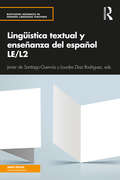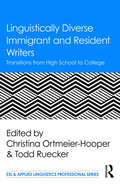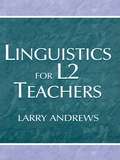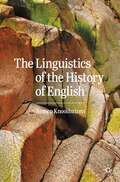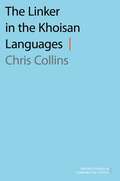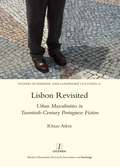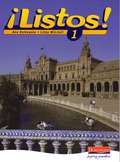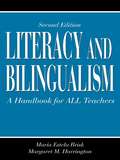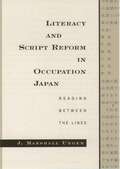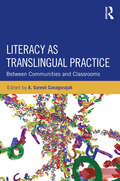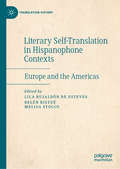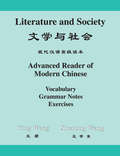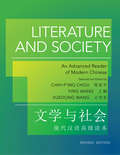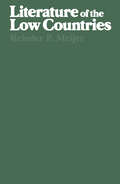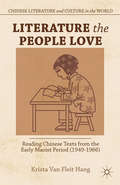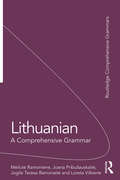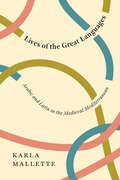- Table View
- List View
Lingüística textual y enseñanza del español LE/L2 (Routledge Advances in Spanish Language Teaching)
by Javier De Santiago-Guervós Lourdes Díaz RodriguezLingüística textual y enseñanza del español LE/L2 ofrece una visión de conjunto teórico-práctica y actualizada de la Lingüística textual aplicada a la enseñanza del español como lengua extranjera y/o segunda, destinada especialmente a estudiantes graduados y a profesores en formación nativos y no nativos. El volumen, escrito por un elenco internacional de profesores-investigadores, presenta una visión actualizada y práctica de los géneros textuales más frecuentes en programaciones universitarias. Enmarcado por una síntesis actualizada de estudios e investigaciones en lingüística aplicada que recorre distintas perspectivas teóricas y metodológicas, recoge datos y propuestas procedentes de aulas de aprendizaje de español de distintos contextos internacionales. Su principal propósito es suscitar la reflexión teórico-práctica sobre los géneros discursivos y su papel en el aula, y ofrecer una descripción pormenorizada de los mismos para proporcionar al profesorado en formación, nativo y no nativo, recursos prácticos y propuestas didácticas que ejemplifican y guían de manera razonada cómo llevar al aula los distintos géneros textuales. Características principales: • Amplitud de aspectos de la lingüística textual y géneros discursivos abordados enteramente para el español LE/L2 y en español. • Estructuración homogénea de los capítulos que facilita la lectura y da coherencia al conjunto. Atención a géneros escritos y orales desde una perspectiva teórico-práctica que puede inspirar nuevas investigaciones. Atención a la diversidad geolectal del español, a los contextos en que este es L2 (Europa, EEUU) y a la de sus aprendices (hablantes de herencia, L2, LE). Orientado a la aplicación práctica y docente en la clase de L2/LE, cada capítulo dedicado a un género incluye consejos, pautas o actividades para el aula. Incluye temática actual en lingüística textual y aprendizaje de lenguas: escritura académica, divulgación científica, textos jurídicos, aprendizaje mediado por ordenador o el lenguaje de las redes. Capítulos bien fundamentados teórica y bibliográficamente, con sólido respaldo de datos empíricos procedentes de corpus, bien contextualizados. Aborda los aspectos teóricos tradicionales relativos al estudio de la tipología textual y los desafíos metodológicos que afronta el profesor al llevar al aula los distintos géneros discursivos. La presente obra presenta, en un solo volumen, una visión actualizada y práctica de los tipos textuales y géneros discursivos de uso más frecuente desde una perspectiva teórico-práctica: presentación, descripción y puesta en práctica es un esquema de trabajo directo y enormemente útil para su aplicación en el aula. El ámbito internacional en el que se mueven los autores le da una amplitud nunca antes recogida en una obra de lingüística textual. Todo ello hace de Lingüística textual y enseñanza del español LE/L2 una obra de consulta obligada para docentes de español como LE/L2, para estudiantes graduados y formadores de profesores, así como para cualquier persona que desee adquirir una perspectiva actual sobre lingüística textual, géneros discursivos y enseñanza e investigación en español nativo y no nativo.
Linguistically Diverse Immigrant and Resident Writers: Transitions from High School to College (ESL & Applied Linguistics Professional Series)
by Todd Ruecker Christina Ortmeier-HooperSpotlighting the challenges and realities faced by linguistically diverse immigrant and resident students in U.S. secondary schools and in their transitions from high school to community colleges and universities, this book looks at programs, interventions, and other factors that help or hinder them as they make this move. Chapters from teachers and scholars working in a variety of contexts build rich understandings of how high school literacy contexts, policies such as the proposed DREAM Act and the Common Core State Standards, bridge programs like Upward Bound, and curricula redesign in first-year college composition courses designed to recognize increasing linguistic diversity of student populations, affect the success of this growing population of students as they move from high school into higher education.
Linguistically Diverse Immigrant and Resident Writers: Transitions from High School to College (ESL & Applied Linguistics Professional Series)
by Todd Ruecker Christina Ortmeier-HooperSpotlighting the challenges and realities faced by linguistically diverse immigrant and resident students in U.S. secondary schools and in their transitions from high school to community colleges and universities, this book looks at programs, interventions, and other factors that help or hinder them as they make this move. Chapters from teachers and scholars working in a variety of contexts build rich understandings of how high school literacy contexts, policies such as the proposed DREAM Act and the Common Core State Standards, bridge programs like Upward Bound, and curricula redesign in first-year college composition courses designed to recognize increasing linguistic diversity of student populations, affect the success of this growing population of students as they move from high school into higher education.
Linguistics for L2 Teachers
by Larry AndrewsLinguistics for L2 Teachers is designed to help bilingual and ESL teachers better understand how and why the English language works, and to broaden their abilities to help their students learn about the various functions of English in the real world. It is not a complete curriculum in English linguistics, but rather, a foundation from which teachers can continue to grow and to teach with greater confidence. The reader-friendly, conversational style makes the concepts easily accessible to preservice and in-service teachers who have little or no previous experience in language study. This textbook: * explains various aspects of English using non-technical terminology; * goes beyond the study of grammar to examine the functions of language, not just its form; * presents language applications in L2 classrooms; and * clearly delineates the significance of chapter topics for L2 teachers and students. Each chapter includes prereading activities to enhance the reader's comprehension; postreading activities to expand and elaborate the concepts; and interactive "Be A Linguist" activities to help readers think in ways similar to the ways linguists think and to provide opportunities to apply ideas explained within the chapter. Intended for all teachers of students for whom English is a new language, this text will help them be better prepared to meet the important challenges and questions they encounter in their classrooms.
Linguistics for L2 Teachers
by Larry AndrewsLinguistics for L2 Teachers is designed to help bilingual and ESL teachers better understand how and why the English language works, and to broaden their abilities to help their students learn about the various functions of English in the real world. It is not a complete curriculum in English linguistics, but rather, a foundation from which teachers can continue to grow and to teach with greater confidence. The reader-friendly, conversational style makes the concepts easily accessible to preservice and in-service teachers who have little or no previous experience in language study. This textbook: * explains various aspects of English using non-technical terminology; * goes beyond the study of grammar to examine the functions of language, not just its form; * presents language applications in L2 classrooms; and * clearly delineates the significance of chapter topics for L2 teachers and students. Each chapter includes prereading activities to enhance the reader's comprehension; postreading activities to expand and elaborate the concepts; and interactive "Be A Linguist" activities to help readers think in ways similar to the ways linguists think and to provide opportunities to apply ideas explained within the chapter. Intended for all teachers of students for whom English is a new language, this text will help them be better prepared to meet the important challenges and questions they encounter in their classrooms.
The Linguistics of the History of English
by Remco KnooihuizenThis textbook approaches the history of English from a theoretical perspective. The book provides a brief chronological overview describing the way in which the English language has changed over time from Old English to Modern English, while subsequent parts adopt a theoretical focus that is thematically organised to deal with the question of how and why English changed in the way it did, including a part addressing some specific contact-induced changes and key topics such as English as a Lingua Franca. Supported throughout with information boxes with empirical studies, the examples given are all drawn from English, but boxes with examples from other languages tie the development of the English language into changes in other contexts and settings. This book is an ideal resource for undergraduate students of the English Language and historical linguistics.
LINKER IN KHOISAN LANGUAGES OSCS C (Oxford Studies in Comparative Syntax)
by Chris CollinsThe linker introduces ("links") a variety of expressions into the verb phrase, including locatives, the second object of a double object construction, the second object of a causative, instruments, subject matter arguments, and adverbs. This volume collects together Chris Collins's published work on the linker in the Khoisan languages. Here, Collins offers a systematic description of the linker in [lHoã, Ju|'hoan, N|uu, and to a lesser extent !Xoõ and |Xam. For each language, Collins illustrates various uses of the linker, drawing attention to cross-linguistic generalizations as well as to variation between the languages. The work presented in this volume should be of interest to researchers working in a wide variety of syntactic frameworks on different languages of the world.
The Linker in the Khoisan Languages (Oxford Studies in Comparative Syntax)
by Chris CollinsThe linker introduces ("links") a variety of expressions into the verb phrase, including locatives, the second object of a double object construction, the second object of a causative, instruments, subject matter arguments, and adverbs. This volume collects together Chris Collins's published work on the linker in the Khoisan languages. Here, Collins offers a systematic description of the linker in [lHoã, Ju|'hoan, N|uu, and to a lesser extent !Xoõ and |Xam. For each language, Collins illustrates various uses of the linker, drawing attention to cross-linguistic generalizations as well as to variation between the languages. The work presented in this volume should be of interest to researchers working in a wide variety of syntactic frameworks on different languages of the world.
Lisbon Revisited: Urban Masculinities in Twentieth-Century Portuguese Fiction
by Rhian AtkinTwentieth-century Portugal saw dramatic political and social change. The monarchy was abolished, and a republic installed (1910), soon giving way to a long-lasting dictatorship (1926); a transition to democracy (1974) led to membership of the European Union (1986). But what do we know of how people lived during these periods? And how did men, in particular, respond to the changes taking place in society? In this illuminating and broad-ranging study, Rhian Atkin uses as case studies the work of Fernando Pessoa (1888-1935), Luis de Sttau Monteiro (1926-93) and Jose Saramago (1922-2010) in order to examine the relationship between socio-political change and the construction and performance of masculinities in the urban environment of Lisbon over the course of the last century.
Lisbon Revisited: Urban Masculinities in Twentieth-Century Portuguese Fiction
by Rhian AtkinTwentieth-century Portugal saw dramatic political and social change. The monarchy was abolished, and a republic installed (1910), soon giving way to a long-lasting dictatorship (1926); a transition to democracy (1974) led to membership of the European Union (1986). But what do we know of how people lived during these periods? And how did men, in particular, respond to the changes taking place in society? In this illuminating and broad-ranging study, Rhian Atkin uses as case studies the work of Fernando Pessoa (1888-1935), Luis de Sttau Monteiro (1926-93) and Jose Saramago (1922-2010) in order to examine the relationship between socio-political change and the construction and performance of masculinities in the urban environment of Lisbon over the course of the last century.
Listos! 1 Pupil Book
by Kolkowska Ana Mara Mitchell LibbyThis text provides an introduction to Spanish for pupils in Years 7 and 8, using two-page units with grammar explanations, end-of-chapter checklists and revision tests.
Literacy and Bilingualism: A Handbook for ALL Teachers
by Maria Estela Brisk Margaret M. HarringtonThis handbook applies proven techniques, derived from bilingual/bicultural classrooms, to teaching literacy in the twenty-first century. Its goal is to help teachers increase their understanding of bilingual learners in order to maximize instruction. Teachers can use this handbook to expand their understanding of literacy and bilingualism; implement literacy approaches and assess students’ development; and learn through reflection. Practical, flexible format and content. Complete and straightforward instructions, illustrated by case studies, allow teachers to use the strategies in this handbook on their own or in teacher-led study groups. They can select from the variety of approaches the ones which best match their students’ needs and their own teaching style. Student-centered focus. All of the approaches share characteristics that help motivate students of varying language abilities to develop literacy. Field-tested approaches. The approaches have been modified and tested with bilingual students of different ages and language backgrounds in bilingual, ESL, mainstream, special education, and deaf education classes ranging from preschool through high school. New in the Second Edition: *five new approaches with their corresponding classroom implementation;*additional information in each introduction addressing its theme;*new material on issues of language, culture, and literacy development of students completely new to the English language; and*annotated bibliographies with sample books to support literacy within language and content area classes. Literacy and Bilingualism is intended for a broad audience of teachers in any type of classroom where bilingualism plays a role, and is an excellent text for preservice and inservice courses that prepare teachers to work with English language learners.
Literacy and Bilingualism: A Handbook for ALL Teachers
by Maria Estela Brisk Margaret M. HarringtonThis handbook applies proven techniques, derived from bilingual/bicultural classrooms, to teaching literacy in the twenty-first century. Its goal is to help teachers increase their understanding of bilingual learners in order to maximize instruction. Teachers can use this handbook to expand their understanding of literacy and bilingualism; implement literacy approaches and assess students’ development; and learn through reflection. Practical, flexible format and content. Complete and straightforward instructions, illustrated by case studies, allow teachers to use the strategies in this handbook on their own or in teacher-led study groups. They can select from the variety of approaches the ones which best match their students’ needs and their own teaching style. Student-centered focus. All of the approaches share characteristics that help motivate students of varying language abilities to develop literacy. Field-tested approaches. The approaches have been modified and tested with bilingual students of different ages and language backgrounds in bilingual, ESL, mainstream, special education, and deaf education classes ranging from preschool through high school. New in the Second Edition: *five new approaches with their corresponding classroom implementation;*additional information in each introduction addressing its theme;*new material on issues of language, culture, and literacy development of students completely new to the English language; and*annotated bibliographies with sample books to support literacy within language and content area classes. Literacy and Bilingualism is intended for a broad audience of teachers in any type of classroom where bilingualism plays a role, and is an excellent text for preservice and inservice courses that prepare teachers to work with English language learners.
Literacy as Translingual Practice: Between Communities and Classrooms
by A. Suresh CanagarajahThe term translingual highlights the reality that people always shuttle across languages, communicate in hybrid languages and, thus, enjoy multilingual competence. In the context of migration, transnational economic and cultural relations, digital communication, and globalism, increasing contact is taking place between languages and communities. In these contact zones new genres of writing and new textual conventions are emerging that go beyond traditional dichotomies that treat languages as separated from each other, and texts and writers as determined by one language or the other. Pushing forward a translingual orientation to writing—one that is in tune with the new literacies and communicative practices flowing into writing classrooms and demanding new pedagogies and policies— this volume is structured around five concerns: refining the theoretical premises, learning from community practices, debating the role of code meshed products, identifying new research directions, and developing sound pedagogical applications. These themes are explored by leading scholars from L1 and L2 composition, rhetoric and applied linguistics, education theory and classroom practice, and diverse ethnic rhetorics. Timely and much needed, Literacy as Translingual Practice is essential reading for students, researchers, and practitioners across these fields.
Literacy as Translingual Practice: Between Communities and Classrooms
by A. Suresh CanagarajahThe term translingual highlights the reality that people always shuttle across languages, communicate in hybrid languages and, thus, enjoy multilingual competence. In the context of migration, transnational economic and cultural relations, digital communication, and globalism, increasing contact is taking place between languages and communities. In these contact zones new genres of writing and new textual conventions are emerging that go beyond traditional dichotomies that treat languages as separated from each other, and texts and writers as determined by one language or the other. Pushing forward a translingual orientation to writing—one that is in tune with the new literacies and communicative practices flowing into writing classrooms and demanding new pedagogies and policies— this volume is structured around five concerns: refining the theoretical premises, learning from community practices, debating the role of code meshed products, identifying new research directions, and developing sound pedagogical applications. These themes are explored by leading scholars from L1 and L2 composition, rhetoric and applied linguistics, education theory and classroom practice, and diverse ethnic rhetorics. Timely and much needed, Literacy as Translingual Practice is essential reading for students, researchers, and practitioners across these fields.
Literary Self-Translation in Hispanophone Contexts - La autotraducción literaria en contextos de habla hispana: Europe and the Americas - Europa y América (Translation History)
by Lila Bujaldón de Esteves Belén Bistué Melisa StoccoThis edited book contributes to the growing field of self-translation studies by exploring the diversity of roles the practice has in Spanish-speaking contexts of production on both sides of the Atlantic. Part I surveys the presence of self-translation in contemporary Indigenous literatures in Spanish America, with a focus on Mexico and the Mapuche poetry of Chile and Argentina. Part II proposes to incorporate self-translation into the history of Spanish-American literatures- including its relation with colonial multilingual-translation practices, the transfers it allowed between the French and Spanish-American avant-gardes, and the insertion it offered for exiled Republicans in Mexico. Part III develops new reflections on the Iberian realm: on the choice between self and allograph translation Basque writers must face, a new category in Xosé Dasilva’s typology, based on the Galician context, and the need to expand the analysis of directionality in Catalan self-translations. This book brings together contributions from some of the leading international experts in translation and self-translation, and it will be of interest to scholars and students in the fields of Translation Studies, Cultural Studies, Comparative Literature, Spanish Literature, Spanish American and Latin American Literature, and Amerindian Literatures.
Literature and Society: Advanced Reader of Modern Chinese
by Chih-P'Ing Chou Ying Wang Xuedong WangLiterature and Society, a textbook designed for upper-level students, usually in their fourth year of studying Chinese, contains literary works and essays related to the social sciences. It reflects the social issues China has faced in recent years and represents a new approach to introducing students to various aspects of Chinese society. The textbook contains two sections. The first, entitled "Literature," includes works by Lu Xun, Lin Yutang, Liang Shiqiu, Wang Li, Xie Bingying, and Wang Meng. The selections include essays, short stories, and one play. Each selection reflects a different side of Chinese life, from offering hospitality to guests and haggling over prices to philosophical issues. The second section of the textbook, entitled "Society," includes essays by Fei Xiaotong, Ma Yinchu, Wu Han, Liang Sicheng, and Chen Hengzhe. These works cover six issues: marriage and family, population and ethics, urbanization, intellectuals, minorities, and the preservation of ancient architecture in a modern city. The textbook provides a brief introduction to each author and discussion questions at the end of each piece.
Literature and Society: An Advanced Reader of Modern Chinese
by Chih-P'Ing Chou Ying Wang Xuedong WangSince its first publication in 1999, Literature and Society has been widely used in Chinese-language classes at major universities and language institutions. In this completely revised edition, designed for upper-level students, this classic textbook continues to explore a variety of contemporary Chinese social issues through the study of Chinese literary works and essays.This new edition condenses and consolidates the original two-volume set into one convenient volume. The first section, "Literature," includes essays, short stories, and a play, and features a range of writers: Lu Xun, Lin Yutang, Liang Shiqiu, Wang Li, Xie Bingying, and Wang Meng. The second section, “Society,” includes essays by Fei Xiaotong, Ma Yinchu, Wu Han, Liang Sicheng, and Chen Hengzhe. The selections delve into such subjects as population issues, ethics, marriage, the lives of intellectuals, and challenges faced by minorities in China. Each selection begins with a brief introduction about the author and concludes with discussion questions. The simplified character text and corresponding vocabulary words face each other on adjacent pages, and the traditional character text follows at the end of each lesson.Literature and Society remains an innovative way for students to sharpen their Chinese language abilities while learning more about important areas of Chinese culture.Completely revised editionOriginal two-volume set now consolidated into one convenient volumeSelections of literary works and essays explore contemporary Chinese social issuesEach selection begins with an introduction to the author and concludes with discussion questionsSimplified character text and corresponding vocabulary sit on facing pagesTraditional character text appears at the end of each lesson
Literature of the Low Countries: A Short History of Dutch Literature in the Netherlands and Belgium
by Reinder MeijerIn any definition of terms, Dutch literature must be taken to mean all literature written in Dutch, thus excluding literature in Frisian, even though Friesland is part of the Kingdom of the Netherlands, in the same way as literature in Welsh would be excluded from a history of English literature. Simi larly, literature in Afrikaans (South African Dutch) falls outside the scope of this book, as Afrikaans from the moment of its birth out of seventeenth-century Dutch grew up independently and must be regarded as a language in its own right. . Dutc:h literature, then, is the literature written in Dutch as spoken in the Kingdom of the Netherlands and the so-called Flemish part of the Kingdom of Belgium, that is the area north of the linguistic frontier which runs east-west through Belgium passing slightly south of Brussels. For the modern period this definition is clear anough, but for former times it needs some explanation. What do we mean, for example, when we use the term 'Dutch' for the medieval period? In the Middle Ages there was no standard Dutch language, and when the term 'Dutch' is used in a medieval context it is a kind of collective word indicating a number of different but closely related Frankish dialects. The most important of those were the dialects of the duchies of Limburg and Brabant, and of the counties of Flanders and Holland.
Literature the People Love: Reading Chinese Texts from the Early Maoist Period (1949-1966) (Chinese Literature and Culture in the World)
by Krista Van Fleit HangExamining the production of 'people's literature' in China, this study provides a new interpretive framework with which to understand socialist literature and presents a sympathetic understanding of culture from a period in China's history in which people's lives were greatly and obviously affected by political events.
Lithuanian: A Comprehensive Grammar (Routledge Comprehensive Grammars)
by Meilutė Ramonienė Joana Pribušauskaitė Jogilė Teresa Ramonaitė Loreta VilkienėLithuanian: A Comprehensive Grammar is a complete reference guide to modern Lithuanian grammar. It includes detailed treatment of all grammatical structures and parts of speech, and their semantic and grammatical categories: gender, number, case of nouns, adjectives, numerals and pronouns; degree of comparison of adjectives and adverbs; tense, mood, person, transitivity, aspect and voice of verbs. The morphology chapters describe the formation, inflection and use of the different forms of every part of speech. Under syntax the syntactic relations and types of sentences, the expression of questions and negation, comparison, word order and interpolation are described. All grammatical phenomena are illustrated with examples from the modern language. Descriptions of phonetics and accentuation as well as orthography and punctuation are also included. Lithuanian: A Comprehensive Grammar is an essential reference for learners and users of Lithuanian. It is suitable for independent study and use in schools, colleges, universities and adult classes of all types.
Lithuanian: A Comprehensive Grammar (Routledge Comprehensive Grammars)
by Meilutė Ramonienė Joana Pribušauskaitė Jogilė Teresa Ramonaitė Loreta VilkienėLithuanian: A Comprehensive Grammar is a complete reference guide to modern Lithuanian grammar. It includes detailed treatment of all grammatical structures and parts of speech, and their semantic and grammatical categories: gender, number, case of nouns, adjectives, numerals and pronouns; degree of comparison of adjectives and adverbs; tense, mood, person, transitivity, aspect and voice of verbs. The morphology chapters describe the formation, inflection and use of the different forms of every part of speech. Under syntax the syntactic relations and types of sentences, the expression of questions and negation, comparison, word order and interpolation are described. All grammatical phenomena are illustrated with examples from the modern language. Descriptions of phonetics and accentuation as well as orthography and punctuation are also included. Lithuanian: A Comprehensive Grammar is an essential reference for learners and users of Lithuanian. It is suitable for independent study and use in schools, colleges, universities and adult classes of all types.
Lives of the Great Languages: Arabic and Latin in the Medieval Mediterranean
by Karla MalletteThe story of how Latin and Arabic spread across the Mediterranean to create a cosmopolitan world of letters. In this ambitious book, Karla Mallette studies the nature and behaviors of the medieval cosmopolitan languages of learning—classical Arabic and medieval Latin—as they crossed the Mediterranean. Through anecdotes of relationships among writers, compilers, translators, commentators, and copyists, Mallette tells a complex story about the transmission of knowledge in the period before the emergence of a national language system in the late Middle Ages and early modernity. Mallette shows how the elite languages of learning and culture were only tenuously related to the languages of everyday life. These languages took years of study to master, marking the passage from intellectual childhood to maturity. In a coda to the book, Mallette speculates on the afterlife of cosmopolitan languages in the twenty-first century, the perils of monolingualism, and the ethics of language choice. The book offers insight for anyone interested in rethinking linguistic and literary tradition, the transmission of ideas, and cultural expression in an increasingly multilingual world.
Lives of the Great Languages: Arabic and Latin in the Medieval Mediterranean
by Karla MalletteThe story of how Latin and Arabic spread across the Mediterranean to create a cosmopolitan world of letters. In this ambitious book, Karla Mallette studies the nature and behaviors of the medieval cosmopolitan languages of learning—classical Arabic and medieval Latin—as they crossed the Mediterranean. Through anecdotes of relationships among writers, compilers, translators, commentators, and copyists, Mallette tells a complex story about the transmission of knowledge in the period before the emergence of a national language system in the late Middle Ages and early modernity. Mallette shows how the elite languages of learning and culture were only tenuously related to the languages of everyday life. These languages took years of study to master, marking the passage from intellectual childhood to maturity. In a coda to the book, Mallette speculates on the afterlife of cosmopolitan languages in the twenty-first century, the perils of monolingualism, and the ethics of language choice. The book offers insight for anyone interested in rethinking linguistic and literary tradition, the transmission of ideas, and cultural expression in an increasingly multilingual world.
